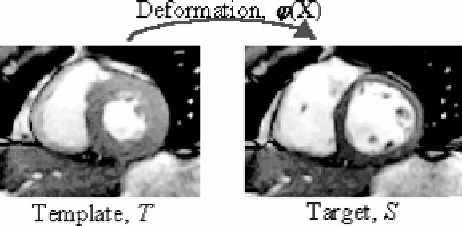Biomedical Engineering Reference
In-Depth Information
Figure 12.1:
The canonical deformable image registration problem involves the
determination of the deformation map that will align a template image with a
target image. In this case, the data are MR images of a heart at different times
during the cardiac cycle.
some segmentation of a surface in the 3-D image dataset. This surface is then
warped into alignment with features in the target image. The pixel-based ap-
proaches do not in general require a segmentation, but rather deform pixels or
some sampling of the pixels.
Most methods for deformable registration incorporate a cost function so that
the overall energy function to be minimized consists of one term based on the
image data itself and a second term that serves to regularize the problem. The
choice of this cost function can have a significant effect on the results of image
registration. The dependence is most significant in regions of the template model
where image texture is sparse or conflicting. In these regions, the registration
solution is computed based on minimizing the deformation potential (Bayesian
prior probability) portion of the particular registration cost functional [14]. A
common approach is to use an analogy to a physical material by treating the
original template image as an elastic sheet [12, 13, 15, 16] or a viscous fluid
[17]. In general, these approaches benefit from the fact that the mapping from
template to target is guaranteed to be one-to-one on the basis of the fundamentals
of deformations as defined in continuum mechanics. However, the particular
kinematic and constitutive assumptions can over-constrain the solution. As an
example, use of the theory of linearized elasticity results in the over-penalization
of large rotations, thus limiting the ability to achieve a good registration.
The objective of this chapter is to describe the theory and application of
a method termed Hyperelastic Warping [16, 18-22] to problems in deformable
image registration. The method is based on the principles of nonlinear solid
mechanics to allow objective tracking of large deformations and rotations and






